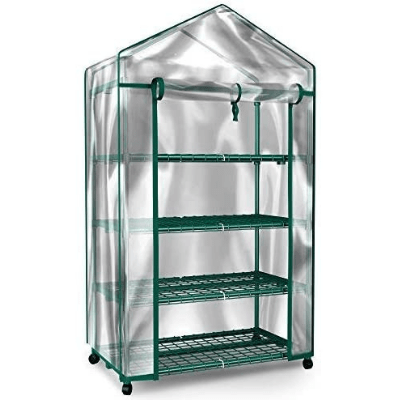
Home-Complete Mini Greenhouse-4-Tier Indoor Greenhouse
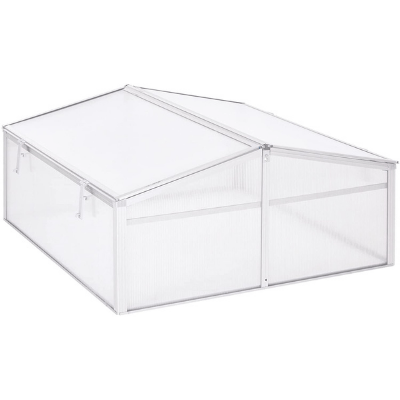
Outsunny 39" Aluminum Vented Cold Frame Mini Greenhouse Kit
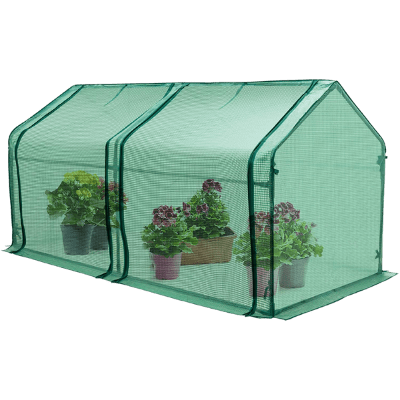
EAGLE PEAK Mini Garden Portable Indoor Greenhouse
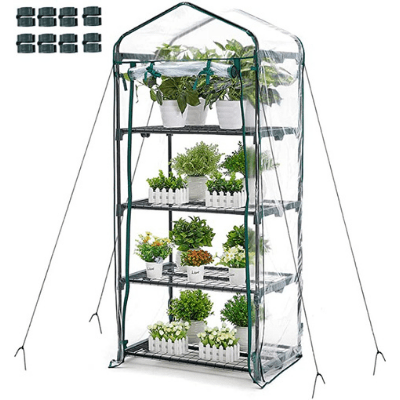
AMERLIFE Greenhouse 4 Tier Indoor Greenhouse
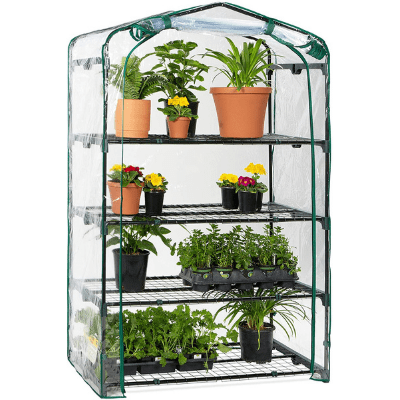
Best Choice Products 40in Wide 4-Tier Mini Greenhouse
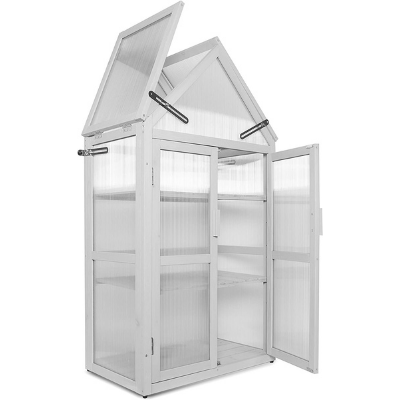
Kitchen Joy Indoor Greenhouse
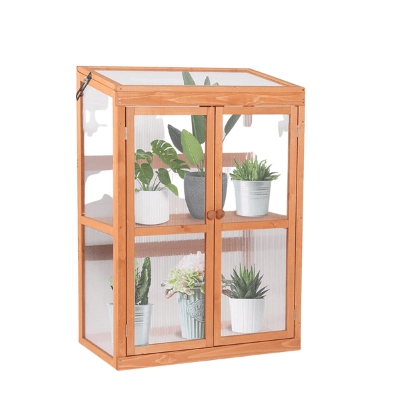
Mcombo Greenhouse Wooden Cold Frame Greenhouse
Growing sustainable food at home has never been easier. Even if you live in an apartment, an indoor greenhouse can keep you supplied with fresh vegetables, herbs, and even fruits all year round.
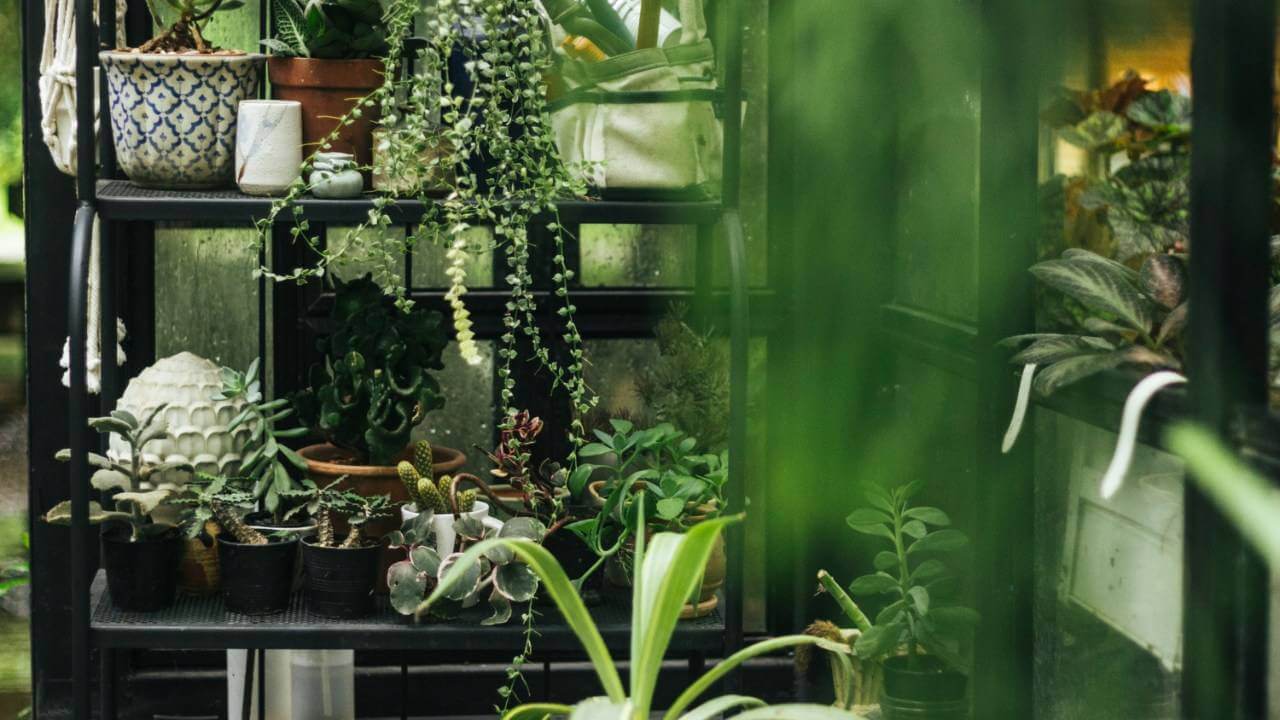
Legend has it that a physician told Emperor Tiberius that he should eat one cucumber a day to stay healthy. The ancient Roman engineers and scholars then had to solve a problem: how do you manage to grow plants all year round?
And that’s when the first known greenhouse was made.
Greenhouses have been popular ever since, especially now when people are more than ever eager to do some gardening and grow sustainable food in their own homes.
Here’s everything you wanted to know about indoor greenhouses.
Why Get An Indoor Greenhouse?
Having an indoor greenhouse gives you a ton of benefits, whether you just want to pluck an occasional basil leaf for your manicotti and a bunch of arugula for your salad, or want a splendid indoor garden for you to grow vegetables and flowers all year long.
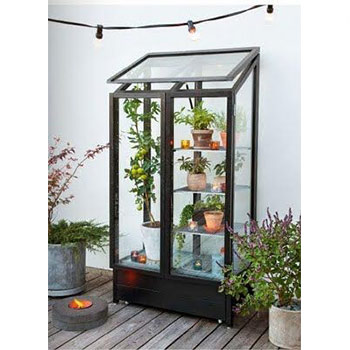
Not everyone is blessed with a backyard though, and for people in apartments, an indoor greenhouse offers all the benefits of true gardening.
But wait!
There are more reasons to get an indoor greenhouse. For example, you can take care of your plant more conveniently.
You can have many off-season fruits and veggies too.
An indoor greenhouse is great because:
1. Great For Big City Apartments
If you live in a big city and don’t have outdoor space for gardening, a small indoor greenhouse or a mini greenhouse is the answer. Even if you don’t have a lot of free space, you’ll be able to fit an indoor greenhouse. For example, place it in the corner of the kitchen counter, on your living room table, or windowsill — this will ensure the garden gets enough sunlight.
Be creative, and look around your home. You don’t need a huge space. You’re bound to find a corner where you can fit your indoor gardening kit.
2. Beautification
An indoor garden will make your living space more beautiful and green. This will be a great conversation topic when you have guests over. Moreover, you’ll be able to serve them with the food you’ve grown yourself.
Also, plants will make your living space healthier, especially if you live in a big city where pollution is the issue.
Finally, the greenification of your home can help battle winter blues and help you through the dark winter months.
3. It’s Easy To Move
If you need to move house, you can easily take your indoor greenhouse apart and relocate it together with your plants.
4. Place It Anywhere
Maybe the climate where you live isn’t ideal for vegetables, or your growing season is too short, or your backyard doesn't see a lot of sunshine. Maybe the soil is not suitable for greens. Having the greenhouse inside solves all these problems. You can always get a portable greenhouse too.
5. Protects Your Plants
Not even heavy rain, wind, or snow can harm your herbs and greens in an indoor greenhouse.
6. Easy to Care
You can regulate the temperature, humidity, as well as easily check your plants for diseases and pests when the greenhouse is close at hand.
Where To Place Your Indoor Greenhouse
You should place your greenhouse where your plants could get plenty of sunlight, like next to a south-facing window or a patio door.
You can also add lighting from a grow light to your greenhouse instead, but keep in mind that sunlight is always best for plants. If you can, at least make a combination of the two, so your plants don't grow on artificial lighting alone.
The ideal spot also needs to be humid and warm.
You also have to consider the size. Once you know what plants you want to grow, you’ll know the size you need, and eventually where to put your greenhouse.
Best Plants For An Indoor Greenhouse
Indoor greenhouses really let you broaden the variety of plants you can grow inside. If you plan ahead and prepare the right conditions, only the ceiling’s the limit.
Vegetables for Your Indoor Greenhouse
Your indoor garden can also save you money at the grocery store. A minute ago they were in the garden, and now they’re on your chopping board. Vegetables to consider include:
Determining The Size Of Your Greenhouse
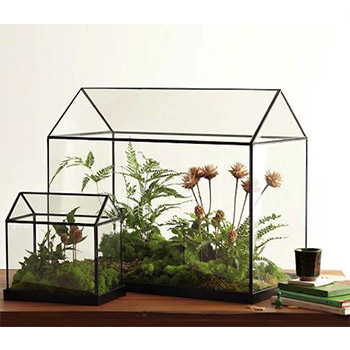
The size of your indoor greenhouse depends on several factors, like the available space you have, its location, and the kind of plants you want to grow.
If it’s just a few herbs and a couple of cherry tomato stalks, a mini-greenhouse made with 5” x 5” grow trays would be enough.
On the other hand, if you want leafy greens, large flowering plants, or even small trees like avocados, you’ll need to take their size into account and do more planning.
If you’re short on space, you can even go vertical, with a five-foot-tall, tiered greenhouse.
How To Build Your Own DIY Indoor Greenhouse?
Before you jump onto building your a DIY greenhouse, you should plan ahead so that things don't messed up later on.
Most plants grow best when nighttime temperatures are 10 to 15 degrees lower than daytime temperatures, so make sure to lower the temperature at night with a small fan.
It’s always better to plant seeds than cuttings as this way you won’t bring any insects into your home.
Use the first few weeks to install optional supplies and adjust the conditions inside the greenhouse.
Step 1: Select The Building Materials
The very first step is to select the frame and glazing materials. There are a few options available in the market right now. Each of them comes with different sets of pros and cons.
First, let's check out the options —
Frame Material Options
For the frame, you need something sturdy to support the weight of the whole structure.
Glazing/Covering Material Options
When you’ve chosen the frame, you need to find the covering which will allow for plenty of sunlight to get through.
Step 2: Create The Ideal Environment For Plant Growth
Sunlight and/or Grow Lights
Sunlight is essential for growing plants, so you should place the greenhouse somewhere it gets the most sunlight throughout the day. Grow lights can help, but can’t replace natural light.
Grow lights are great for winter gardening but keep in mind that they can add up a lot of heat. Make sure you use them with a timer so you don’t pop the corn while still on the stalk.
What Temperature Is Ideal for Your Plants?
Growing plants generally need a temperature range between 65-75°F (18-23°C). Your home probably falls into this scope, but it’s good to have an easy option to control the cooling or heating in indoor greenhouses.
To make it warmer indoors, you can use tea lights or a small electrical heater. Most plants grow best when nighttime temperatures are 10 to 15 degrees lower than daytime temperatures, so make sure to lower the temperature at night with a small fan, which can also make for air circulation.
Humidity IS Important
It’s hard to escape the change of seasons, and even inside your home, plants “feel” that something’s happening outside. To prevent them from losing leaves or turning brown due to low humidity, you should get a humidifier. If not, just make sure to mist the plants at least once a day.
Water and Nutrients
For your plants to flourish, the soil should best be moist but not soggy. As your indoor greenhouse will probably be within your reach, it’ll be easier for you to check the moisture. Unlike outdoors, the amount of nutrients your plants can draw is limited indoor, so you’ll need to make a bit of compost or add organic fertilizer all year round.
Step 3: Get The Supplies And Start Building
The frame and covering apart, you’ll need a few supplies to get your indoor greenhouse up and running. Once you’ve chosen pots or trays, decided on the type of soil and fertilizer, you need to get:
1. Grow Lights
These can be of great help in winter months when there’s little sun, especially inside. They also help if you plant flowers that like high-intensity light. I remind you, grow lights are must for winter greenhouses too.
For me, I use these 70W LED Grow Lights from SANSI.
2. Fans
Use them to lower the greenhouse temperature and improve air circulation. The one that I use in my own indoor greenhouse is this Schaefer Versa-Kool 12" Deep Guard Greenhouse Circulation Fan.
3. Heater
If the temperature, on the other hand, drops too low, a small electric heater like the Bio Green Greenhouse Heater is more than welcome.
4. Hygrometer
If you can see that the humidity level is low, then it’s probably too late for your plants. You should avoid this by adding a small stick-on hygrometer like this Govee Hygrometer + Thermometer.
5. Thermometer
Without a reliable thermometer you’ll be pressed hard to guess the exact temperature inside your greenhouse.
You can use the Govee Hygrometer as well because, fortunately, it's also a thermometer. This means that you can save more since you don't have to buy a separate thermometer anymore.
6. Watering System
Can make your daily maintenance really easy. An automated watering and misting system like the MIXC Mist Irrigation Kit and Plant Watering System is really useful when you go away for a week or two.
How Much Does It Cost To Build An Indoor Greenhouse?
So, are all the homegrown vegetables and herbs worth the cost of the entire home gardening thing?
Yes, without question.
Keep in mind that a lot of these supplies are optional, and it’s you who decides how much your greenhouse is going to cost. A mini greenhouse for annuals and herbs can be made for less than $10, and there are 4-tiered indoor greenhouses that are sold for as little as $30.
If things still seem too expensive, you can always try out container gardening.
Best Indoor Greenhouse Kits To Buy (2022)
If you don’t have the time or materials to build your own indoors greenhouse, you can easily pick one up from the store. I trust Outsunny for this since they’ve been a reliable manufacturer of greenhouses for a long time.
1 - Home-Complete Mini Greenhouse-4-Tier Indoor Greenhouse
The construction is sturdy, so the greenhouse will be safe even if you have small kids or pets. I love that it can hold other items apart from plants, such as heavy books, mid-size appliances, or anything else you need storing. This means you’ll be able to place a heater for your plants, and not worry it’ll knock over the greenhouse.
The greenhouse has four tiers, so there’s plenty of space for your plants or other items.
Finally, the greenhouse has locking caster wheels. You can easily move it from room to room or keep it in place by locking the wheels.
Tech Specs
Pros
Cons
Why Do I Like It?
I like that it has locking wheels. I can move it around my home as needed and lock it in place once I’m done, which means less chance of someone accidentally moving and knocking it.
2 - Outsunny 39" Aluminum Vented Cold Frame Mini Greenhouse Kit
There’s an adjustable roof that will give your plants good ventilation and easy access for you. You can choose how much roof you want to open — a few inches to create a flat top surface or open completely for easier access.
This greenhouse will last for years to come. It has rust-resistant hardware and an aluminum frame, so it’s corrosion-free.
In case you want to use it outside, it’s easy to dismantle. Plus, it’ll keep squirrels and other animals from eating your bulbs.
Pros
Cons
Why Do I Like It?
I love the adjustable roof. It gives easy access, and I can access every inch of the greenhouse when fully opened.
3 - EAGLE PEAK Mini Garden Portable Indoor Greenhouse
It has an extremely easy assembly. You don’t need any tools as all parts are detachable. The greenhouse comes with an instruction sheet so you’ll know exactly what to do.
As you can walk in this greenhouse, there’s plenty of room for you to move and work and grow your plants. You’ll have easy access, thanks to the two zippered roll-up doors.
The material the greenhouse is made of is completely safe — this is thick polyethylene that’s non-toxic and odorless. The greenhouse comes with heavy-duty powder-coated steel pipes, so the cover will be completely secure, and you don’t have to risk knocking it over, no matter if you place it inside or outside.
Pros
Cons
Why Do I Like It?
I love how lightweight but sturdy this indoor greenhouse is. Because it’s lightweight, it’s easy to move around, and it comes with 6 stakes so it can be secured.
4 - AMERLIFE Greenhouse 4 Tier Indoor Greenhouse
It has 4 tiers, which gives you plenty of space to have a proper garden right in your home. Each shelf has 33 lbs capacity, so you’ll be able to fit at least 12 pots. Or, you can use one of the shelves for storing your gardening tools.
The greenhouse is made of a heavy-duty powder-coated steel frame, and it comes with 4 extra wind ropes and hooks. Plus, you’ll get 8 extra net rack buckles which make sure the greenhouse is steady. You can fit heavy pots without worrying it’ll topple over.
There’s a roll-up zippered door, which gives you easy access to the plants and provides them with plenty of ventilation. There are two ribbon ties that make the door stay open.
Pros
Cons
Why Do I Like It?
I like that there are locks for the shelving, which makes it sturdy. I also like that there are ties to the zippered door, so it’s easy to water the plants.
5 - Best Choice Products 40in Wide 4-Tier Mini Greenhouse
It gives plenty of access. There are four zippers, so you can open the top or the bottom of the cover, and a set of fasteners will keep the greenhouse open while you do your gardening.
If you decide to keep it on the patio or a balcony, the PE cover will keep the plants safe from all elements and provide enough humidity, which is especially important for seedlings.
The greenhouse has four shelves. Each of them can hold up to 20 pounds, so you’ll be able to keep both smaller and bigger plants.
Pros
Cons
Why Do I Like It?
I like that the shelves are removable, so I can fit taller potted plants. I also like that both the bottom and top can be opened for extra ventilation.
6 - Kitchen Joy Indoor Greenhouse
Not only will it allow you to grow your own plants, but it’ll enhance your living space.
The greenhouse is made from cedar, which is a better option than plastic. It’s more stable and durable while still lightweight, so you can move it around.
This indoor greenhouse has two adjustable shelves, so you can fit taller plants. There’s also an adjustable roof panel which is secured by loosening and tightening of wingnuts. This makes gardening and watering easy.
This cabinet greenhouse comes with pre-fitted feet, which makes the assembly easy. The feet keep the greenhouse off the ground. This ensures the wood isn’t in extended contact with water.
Pros
Cons
Why Do I Like It?
I like its stylish design. It looks different from all other greenhouses on the market. Plus, it’s small, so you’ll be able to fit it anywhere.
7 - Mcombo Greenhouse Wooden Cold Frame Greenhouse
It has one shelf in the middle that’s adjustable, so you can fit plants that are different heights.
The panels are transparent polycarbonate, so your plants will have maximum light transmission. They also aid heat retention for early sed sprouts. Your plants will have enough sun to grow healthy.
Finally, the greenhouse has a roof that can be opened. There’s a bolt on the side that you can use to keep the roof open. You can also control the size of the vents by holding the screws in different rods positions. Thanks to this, your plants will always have good ventilation.
Pros
Cons
Why Do I Like It?
I like that it’s made of wood. It’s a more eco-friendly option. Plus, I can paint the wood any color I like and make it pop even more.
Start Your Own Garden With an Indoor Greenhouse
An indoor greenhouse will allow you to grow your gardening skills and have your own plants all year round. This is also a great way to be more eco-friendly and healthy — you’ll know exactly where your food came from. Or, use an indoor greenhouse to always have fresh flowers.
If you have enough space, you can choose a bigger option. But, if you live in a small apartment, that’s fine too. There are plenty of small indoor greenhouses to choose from. Go for something lightweight if you plan to move your greenhouse, or for a wood one if you’ll keep your greenhouse in one place.
With so many options out there, you’re bound to find a greenhouse that’ll work for you. Order one today, and start working on your indoor gardening skills.


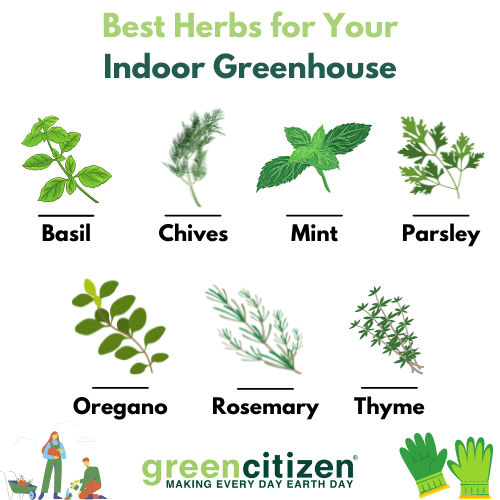
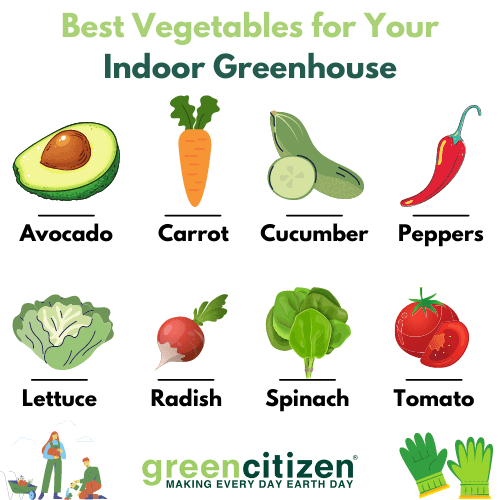
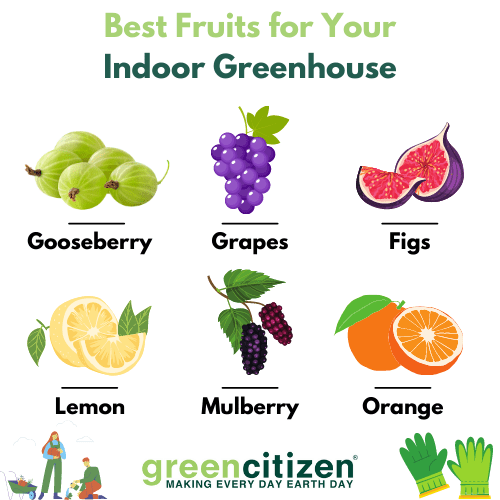



I have a greenhouse on a shelf I made but the bottom isn’t quite sealed. Does the bottom of a greenhouse need to be sealed for it to work properly?
Pingback: Everything you need to know about Microgreen Aquaponics – Japan Aquaponics
I’m so excited to start growing my own vegetables in my indoor greenhouse!
Pingback: Greenhouse Safety Glass – A Strong And Durable Glass For Greenhouses – Tail Wags
Where can I find the black greenhouse cabinet pictured next to “Why Get an Indoor Greenhouse?”?
Pingback: Spring Gardening 101: What to Plant, What to Harvest, & Planning Your Garden - Urban Leaf website
Pingback: What Are Indoor Greenhouses and Why You Should Get One – The Spicy Trio